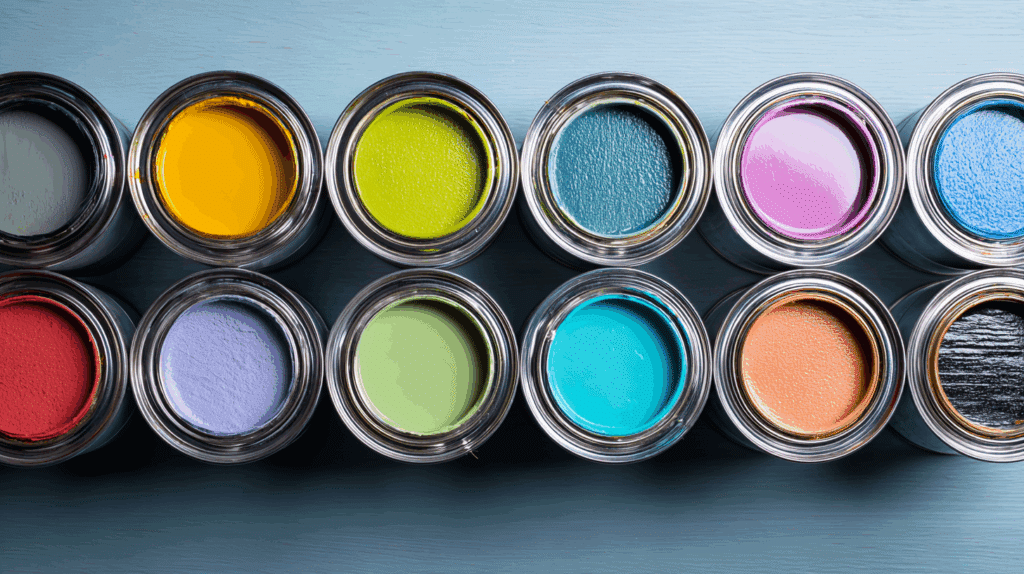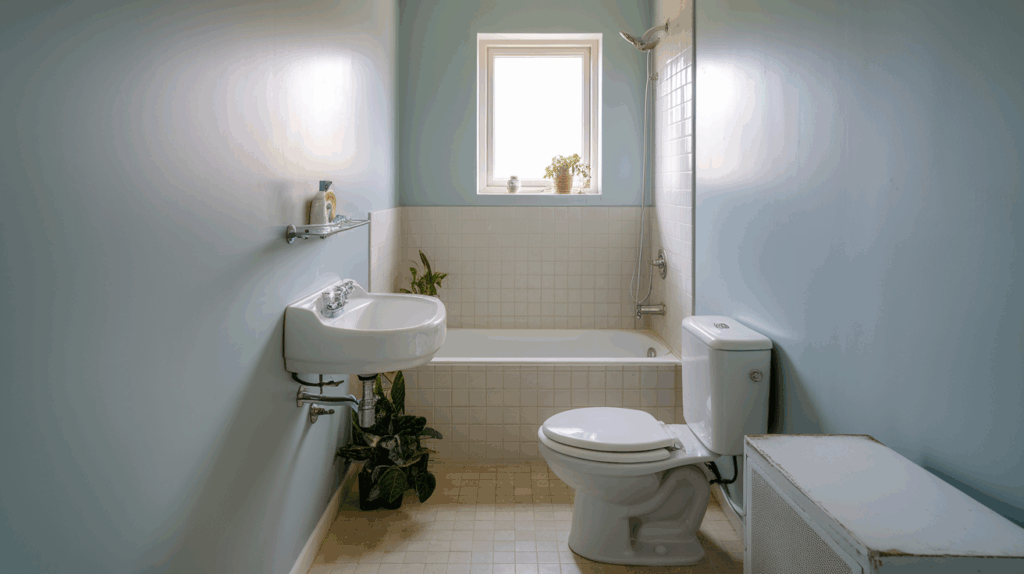Painting bathrooms is tricky. Trust me, I learned this the hard way.
Last year, after repainting my small, windowless bathroom, I noticed mold spots after only a few weeks. The paint started peeling off near the shower. It was a hassle to redo everything.
If you’re here, you probably faced something similar or want to avoid it completely. You need paint that can handle lots of steam, water splashes, and daily humidity.
This article covers everything you need to know about picking the best paint for high-humidity bathrooms.
You’ll find out what makes paint moisture-resistant, top brands to choose from, painting tips, personal recommendations, and whether DIY or professional painting is best for you.
Why Moisture-Resistant Paint Matters in Bathrooms?

High humidity is tough on regular paint. Steam from showers makes the air wet. This moisture settles on walls and ceilings, causing issues like:
- Mold and mildew
- Peeling or bubbling paint
- Damage to drywall
Mold isn’t just ugly; it’s unhealthy. Breathing mold spores can cause breathing problems, allergies, and even asthma flare-ups.
Moisture-resistant paint helps avoid these problems. It’s specially made to stop moisture from getting under the paint surface.
It keeps walls looking good and protects your family’s health by preventing mold growth.
Key Features to Look for in Bathroom Paint
Not all bathroom paints are the same. Here’s what to look for to make sure you’re picking the right one:
- Moisture Resistance: Stops water from soaking through the paint.
- Mold & Mildew Resistance: This has ingredients that fight mold and mildew.
- Durability: Strong enough to handle regular cleaning and scrubbing.
- Low VOCs: Fewer chemicals mean healthier air inside your home.
Checking these features will save you from repainting sooner than you’d like.
Best Paint Types for Humid Bathrooms

Choosing the right type of paint matters as much as the finish. Here’s a breakdown:
Acrylic Paints
Acrylic paints are water-based and known for their excellent durability and moisture resistance. They’re often the go-to choice for bathrooms due to their ability to withstand high humidity without peeling or discoloring.
Ideal for quick clean-ups, acrylic paints are easy to work with and offer a long-lasting, smooth finish.
Pros: Great durability; withstands frequent use and moisture. And excellent moisture resistance, perfect for high-humidity spaces like bathrooms.
Cons: May need a few coats for best coverage if you’re covering dark colors.
Latex Paints
Latex paints are another water-based option, offering a fast-drying, low-odor solution for bathroom walls. They are easier to apply and clean than oil-based paints, but they might not hold up as well in extremely humid conditions.
Despite this, they are still a popular choice for bathrooms due to their smooth finish and ease of use.
Pros: Latex paints dry quickly, which makes them perfect if you want to finish your painting project in less time. They also have a low odor, making the painting process more comfortable without strong fumes lingering.
Cons: However, latex paints are not as durable as oil-based paints, especially in areas with constant moisture like bathrooms. They may not hold up as well in extreme conditions.
Oil-Based Paints
Oil-based paints are known for their toughness and longevity. These paints are resistant to water, which makes them suitable for areas with high moisture levels.
While they take longer to dry and have a stronger odor, oil-based paints provide a durable finish that can last for years, making them a strong choice for high-humidity environments.
Pros: Oil-based paints are incredibly durable, making them ideal for long-lasting results. They also work well in high-moisture environments, offering extra protection for spaces like bathrooms.
Cons: On the downside, oil-based paints have a long drying time, which can be inconvenient if you’re looking to finish the job quickly.
They also have a strong odor and contain VOCs (volatile organic compounds), so it’s important to ensure proper ventilation while applying them.
Top Moisture-Resistant Paint Brands
Choosing trusted brands is a safe bet. Here are four top-rated choices:
- Zinsser PERMA-WHITE: Stops mold growth and doesn’t need primer. Easy to apply, even for beginners.
- KILZ Interior/Exterior Waterproofing Paint: Perfect for very damp bathrooms. Protects against moisture extremely well.
- Behr Premium Plus Ultra: Combines paint and primer in one. Good coverage and resists mildew.
- Benjamin Moore Aura® Bath & Spa: Designed specifically for high-humidity bathrooms. Holds up exceptionally well over time.
Each of these brands gets solid reviews from homeowners who’ve tested them in their bathrooms.
Top Paint Finishes for High-Humidity Bathrooms
Paint finishes matter. Here are the best types for bathrooms:
- Semi-Gloss: Shiny finish that’s easy to clean. It handles moisture well and is great for areas near showers or tubs.
- Satin: A middle ground, less shiny but still easy to wipe clean. Good for bathrooms that aren’t extremely humid.
- Eggshell: Slightly matte finish, suitable if your bathroom isn’t too steamy. Less durable than satin or semi-gloss but still moisture-resistant.
My bathroom has semi-gloss, and it’s holding up great, even with hot showers every day.
DIY vs. Professional Painting in Bathrooms
Deciding whether to paint yourself or hire someone depends on your comfort level, time, and budget. Here’s a quick comparison to help you decide:
| Aspect | DIY Painting | Professional Painting |
|---|---|---|
| Cost | Lower – you buy only paint and tools | Higher – includes labor and possibly materials |
| Time | Takes longer, especially if you’re new to it | Usually faster – pros work efficiently |
| Control | Full control over colors, timing, and process | Limited – depends on the painter’s schedule |
| Quality | Can vary – depends on your skill level | Consistent, polished finish |
| Effort | Requires physical effort and prep work | Minimal effort on your part |
| Satisfaction | Rewarding to complete it yourself | Less hands-on, but less stress too |
| Risk of Mistakes | Higher – especially if you skip steps or rush | Lower – professionals know how to avoid issues |
I painted my bathroom myself because it’s small. But if your bathroom is larger or if you’re unsure about DIY skills, hiring someone is probably the better choice.
Color Recommendations for Different Types of Bathrooms
When choosing colors for different bathroom sizes, I’ve learned that the right shades can make a huge difference.
| Bathroom Type | Color Recommendations | Quick Tips |
|---|---|---|
| Small or Windowless Bathroom | Soft White or Cream, Pale Blue or Aqua, Light Gray, Warm Beige or Taupe, Pastel Green | Stick with light shades, Paint ceilings with white or pale shades, Avoid overly bright/dark colors |
| General Bathroom | Soft White, Pale Blue, Light Gray, Warm Beige, Soft Pastels | Balance light and dark shades for contrast, Use accent walls or tiles for interest |
| Large Bathroom | Warm Tones (Deep Taupe, Earthy Browns), Bold Colors (Navy, Charcoal) | Bold accent walls work, Use a mix of lighting to create depth |
These color choices transformed my bathroom into a space I actually enjoy spending time in. Give them a try!
Maintenance Tips to Prolong Paint Life
After painting, follow these simple steps to keep your bathroom walls looking good longer:
- Clean walls regularly with mild soap and water to stop mold from starting.
- Use your exhaust fan every time you shower. Keep it running for at least 20 minutes after finishing your shower.
- Quickly fix leaks or plumbing issues. Water left unnoticed quickly ruins paint jobs.
These easy habits will save you time and money in the long run.
Conclusion
Picking the best paint for your humid bathroom doesn’t have to be complicated. Remember, the key is finding paint that fights moisture and mold.
Now that you know what to look for in a good paint, like moisture resistance, the best finishes, and top brands, you’re ready to make your choice. Don’t forget that preparation is key!
Take the time to clean and prime your walls, and make sure to maintain your paint job by keeping things clean and using exhaust fans when needed.
Feel free to drop a comment with any questions or share your bathroom painting experience below.
Good luck with your project!

